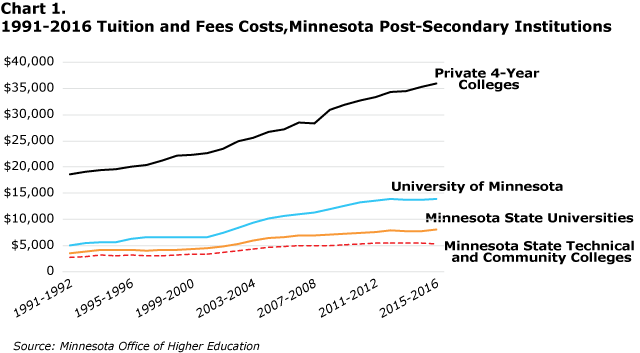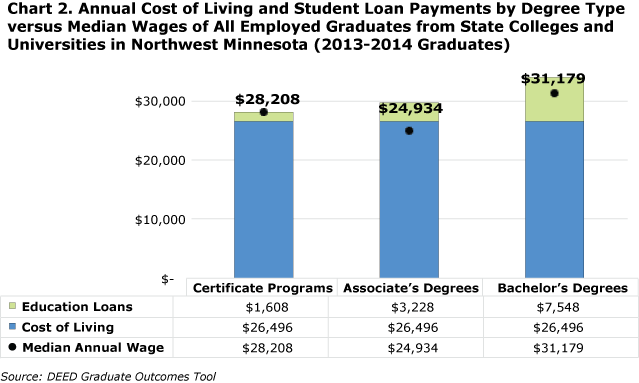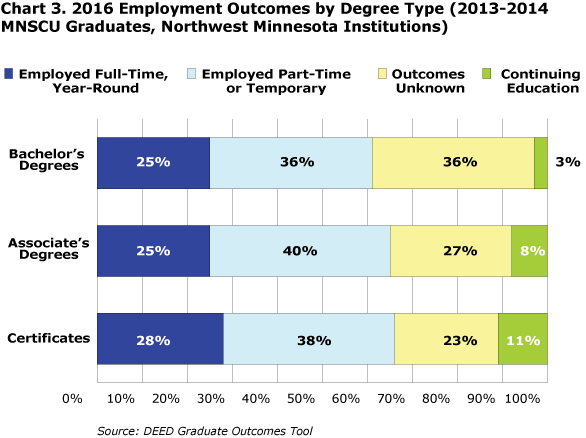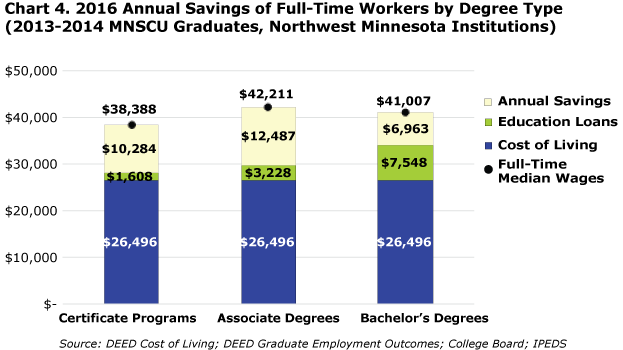by Chet Bodin
October 2016
Post-secondary education has always been an important factor in economic success, but the rising costs of college can be a worrisome subject for job seekers who want to get the most out of their investment. Since 1985 the cost of higher education has surged by more than 538 percent according to Bloomberg News. In Minnesota the cost of education has increased at a slower but very high rate as well. The Office of Higher Education provides an historical look at the cost of tuition and fees at various types of post-secondary institutions over time. Weighted for inflation, post-secondary tuition and fees here have increased between 94 percent at private four-year colleges to 175 percent at the University of Minnesota since 1991 (see Chart 1).

This trend leads many to question what type of post-secondary education is right given their current financial situation and the potential earnings. In 2015 over two-thirds of job vacancies in Northwest Minnesota required no more than a high school diploma, but were for lower paying jobs, so the decision to invest in post-secondary education is critical in the region. Considering that the full cost of education can extend well beyond tuition, the decision can be a difficult one. Annual expenses may also include room, board, transportation, and personal expenses — to name a few. And while working while in school has become a popular option, and working students tend to borrow less than those who do not work, it may not always be an option.
Table 1 itemizes typical education costs by institution type by looking at the amount of federally-subsidized loans needed to pay annual expenses, minus the average amount of combined state and local grants awarded. In reality, total education costs will vary by school location, cost of living before and after graduating, personal savings, and household income. However, as a baseline for analysis, Table 1 looks at average total costs of attending Minnesota State Colleges and Universities in Northwest Minnesota if these expenses are borrowed in entirety.
| Table 1. Average Cost of Education, State Colleges and Universities in Northwest Minnesota, 2014 | |||
|---|---|---|---|
| Cost Category | Certificate (less than Bachelor's) | Associate's Degree | Bachelor's Degree |
| Total Annual Expenses | $17,108 | $17,108 | $19,642 |
| Tuition and Fees | $5,400 | $5,400 | $8,229 |
| Room and Board | $6,299 | $6,299 | $7,925 |
| Books and Supplies | $1,270 | $1,270 | $850 |
| Other Expenses | $4,139 | $4,139 | $3,026 |
| Combined State and Federal Grants | ($4,203) | ($4,203) | ($4,580) |
| Net Annual Costs | $12,905 | $12,905 | $15,062 |
| Award Years | 1 | 2 | 4 |
| Total Education Cost | $12,905 | $25,810 | $60,248 |
| Source: Integrated Postsecondary Education Data System (IPEDS) | |||
In this scenario annual costs of education at four-year universities exceed those at two-year colleges, but not by as much as you might think. According to the National Center for Education Statistics, tuition/fees and room/board cost more at regional state universities (Bemidji State and Minnesota State University-Moorhead), but other expenses such as those for transportation and personal items are less. Universities are more likely to offer on-campus room and board options like dorms and apartments, compared to the regional state community and technical colleges (Alexandria, Bemidji, Brainerd, Detroit Lakes, Fergus Falls, Moorhead, Thief River Falls, and Wadena), which rarely do. Therefore, students at two-year colleges tend to live off-campus and drive to school, which may help explain these differences; although the total cost of room and board and other expenses varied by only about $500 between colleges and universities.
Greater cost differences are accumulated in multi-year programs and with the additional interest on what is borrowed to complete such degrees. Borrowers have several options to cover these costs including private loans from banks and credit unions. However, most first-year, full-time students are eligible for federally-subsidized loans at 4.66 percent interest. Based on that, certificate completers paying off an average of $12,905 in student loans over a 10-year period would need to pay $1,608 per year. Associate degree holders who compiled $25,810 in loans would need to pay $3,228 per year for 10 years, and students who borrowed $60,248 to earn a bachelor's degree would have annual payments of $7,548 over 10 years.
To understand how the costs of varying degree programs compare to their potential benefits, DEED data tools can provide guidance to a prospective student, parent, or policy maker. The Graduate Employment Outcomes (GEO) tool shows how well recent graduates fare after they've finished school and joined the workforce. Both statewide and regional data show that after two years in the workforce, 2013-14 graduates with Bachelor's degrees from state colleges and universities are earning more than those with Associate's degrees and Certificates. Yet, as noted above, degree type can also heavily influence subsequent loan payments and, thus, a graduate's post-college standard of living.
Education costs for Bachelor's degrees may greatly exceed those of Certificate programs and Associate's degrees as shown in Table 1 and especially Chart 2 — chiefly if the total cost of education is borrowed. Only the median wage of those who earned one-year certificates exceeded the combined cost of living and their education. The median wage of those with Associate's degrees fell short of these expenses by $4,790, and the median wage of those with Bachelor's degrees were short by $2,865. Luckily, student debt can vary by the amount of grants, scholarships, and student earnings while in school, potentially driving down post-graduation debt. Still, certificate holders were also more likely to be employed after two years in the workforce. Two thirds of 2013-14 certificate graduates were employed in some form by 2016, and 28 percent were employed full-time, year round.

Full-time, year-round employment is often the goal for these students. The data show, however, that not all graduates are able to secure such jobs. Among 2013-14 graduates, only 25 percent of graduates who earned Associate's degrees and Bachelor's degrees found employment full-time, year-round by 2016 (see Chart 3). These results reflect only employment in Minnesota, and it should be noted that the high rate of Bachelor's degrees graduates with unknown outcomes (36 percent) indicates many may be attending graduate school or working elsewhere.


Because certificate holders are more likely to find employment within two years, they run less risk of having to sacrifice basic cost of living standards to pay off education loans. Certificate holders are also most likely to find a full-time, year-round job, which could help them pay off their debt faster. For graduates who found full-time, year-round positions, the median wages were significantly higher for each degree type. Full-time, year-round employees with certificates earned a median annual income of $38,333; compared to $28,208 for all working certificate holders, a difference of more than $10,000. Likewise, graduates with Bachelor degrees from regional universities earned a median annual income of $41,007 when working full-time, year-round compared to $31,179 for all of those employed. However, the difference was the most extreme for Associate's degree holders. Full-time, year-round workers were earning $42,211 a year, over $16,000 more than all of those who were employed with the degree.
Full-time employment outcomes also provide some interesting insight when education loan payments are considered. Again, if the full amount of education was borrowed, certificate holders and those with Associate degrees who found full-time, year-round jobs would have more financial freedom than Bachelor's degree holders who did. Those with Associate degrees would have $5,500 more in-pocket than those with Bachelor degrees, and Certificate holders $4,300. This would not only have had an immediate impact, but a potentially long-term one as well. If one- and two-year degree holders were to use the extra income to pay more of their loans off in a shorter period of time, they could save a significant amount of loan interest. Choosing this path would allow one- and two- year degree holders to gain valuable work experience while trimming their debt. Potentially, they could even return to pursue a higher degree debt-free.
As noted, the cost of college can vary for each person; several factors may influence the amount of education debt incurred which can influence the cost-benefit questions when considering which degree to pursue. According to College Scorecard data, students who graduate from the Minnesota State Colleges and Universities in Northwest Minnesota often borrow less than the full amount outlined above. This would also make annual student loan repayments much less. The median debt for the five community and technical colleges in Northwest Minnesota ranged from $11,000 at Northwest Technical College in Bemidji to $15,750 at Northland Community and Technical College in Thief River Falls (see Table 2).
| Table 2. Median Student Loan Debt for Graduates in Northwest Minnesota, 2014 | ||||
|---|---|---|---|---|
| Institution Name | City | Median Student Loan Debt of Graduates | Median Monthly Loan Repayment | Median Annual Loan Repayment |
| Alexandria Technical and Community College | Alexandria | $12,000 | $133.22 | $1,599 |
| Northwest Technical College | Bemidji | $11,000 | $122.12 | $1,465 |
| Central Lakes College - Brainerd | Brainerd | $12,000 | $133.22 | $1,599 |
| MN State - Detroit Lakes | Detroit Lakes | $13,000 | $144.33 | $1,732 |
| MN State - Moorhead | Moorhead | $13,000 | $144.33 | $1,732 |
| MN State - Wadena | Wadena | $13,000 | $144.33 | $1,732 |
| Northland Community and Technical College | Thief River Falls | $15,750 | $174.87 | $2,098 |
| Average Annual Loan Repayment Amount | $1,708 | |||
| Institution Name | City | Median Student Loan Debt of Graduates | Median Monthly Loan Repayment | Median Annual Loan Repayment |
| Bemidji State University | Bemidji | $21,500 | $238.69 | $2,864 |
| Minnesota State University - Moorhead | Moorhead | $23,056 | $255.96 | $3,072 |
| Average Annual Loan Repayment Amount | $2,968 | |||
| Source: College Scorecard, U.S. Department of Education | ||||
When choosing a post-secondary path, this information may help prospective students gauge the level which previous graduates have been able to manage their education debt. Among those who graduated with Bachelor's degrees, the median annual education loan payments were over $4,500 lower per year than had they borrowed the full amount. The relatively low median debt levels indicate that students in the region have kept their education costs lower, perhaps through savings, attaining credits or scholarship support prior to college, or working while there. In such circumstances a Bachelor's degree program becomes more attractive, financially speaking, but every student's situation will be different. Understanding one's personal situation is paramount, and it would be unsafe to assume one size fits all, especially if education costs continue to grow at their current pace.
When we compare these debt levels to the same employment outcomes of 2013-14 graduates in Northwest Minnesota, the median salaries of all employed bachelor's degree graduates exceeds the combined cost of median annual loan payment of students and annual cost of living in Northwest Minnesota. On the other hand, despite lower levels of debt at the median level, the employment outcomes of Associate's degree graduates still fall below this cost threshold (see Table 3). The median annual wages of Associate's degree holders appears to be lower from the high number of those with liberal arts and/or general studies majors. Of the 1,816 Associate's degree graduates in 2014 who were working in Minnesota two years later, over one third majored in Liberal Arts and Sciences/General Studies. These graduates reported a much lower median annual wage of $12,722, and, as a high percentage of 2014 Associate's degree holders, their employment outcomes drastically affect the median annual salary of the cohort altogether. The median annual wage of Associate's degree graduates who majored in other programs was $31,358 (see Table 3).
| Table 3. Annual Cost of Living and Median Student Loan Payments by Degree Type versus Median Wages for Employed Graduates of State Colleges and Universities in Northwest Minnesota (2014 Graduates | |||||
|---|---|---|---|---|---|
| Degree type | 2014 Graduates Employed in MN | Median Annual Salary (all jobs) | Regional Cost of Living | Median Annual Loan Repayment | Annual Difference |
| Bachelor's | 1,251 | $31,179 | $26,496 | $2,968 | $1,715 |
| Associate's | 1,816 | $24,934 | $26,496 | $1,708 | -$3,270 |
| Liberal Arts Majors | 626 | $12,722 | $26,496 | $1,708 | -$15,482 |
| All Other Majors | 1,190 | $31,358 | $26,496 | $1,708 | $3,154 |
| Source: DEED Graduate Employment Outcomes Tool, College Scoreboard, U.S. Department of Education | |||||
The data show that certificates and associate degrees might lead to lower wage levels, but will almost certainly cost less and lead to more manageable debt payments after completion. More short-term and long-term cost-benefit analysis can help students and parents understand the importance of keeping costs low. Those eager to complete a Bachelor's degree in four years would benefit from a plan to pay down their debt while in school or minimize it by other means. Earning a certificate from a regional state community or technical college offers the least amount of financial risk, both in terms of finding employment and earning enough to meet basic costs of living and paying off whatever debt is accumulated. An Associate's degree also has potential advantages, especially if a student focuses on a technical skill or applies their (less expensive) credits toward an advanced degree. Hopefully, by comparing the potential debt from education to employment outcomes of recent graduates in Northwest Minnesota, those investing in education in Northwest Minnesota will understand their options more clearly.